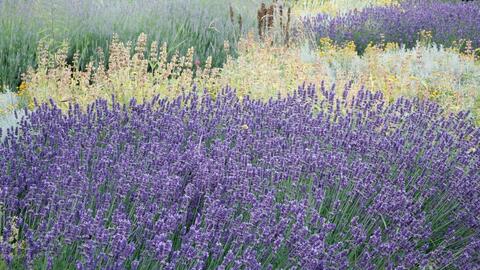Planting Lavender: That’s how you do it
Be it in the flower bed or in a pot on the balcony or the terrace: Keep this in mind while planting Lavender.

Common Lavender in the garden
Planting Lavender is not difficult in itself. The popular Subshrub with its mostly violet-blue flowers exudes a pleasant smell which for many is inseparably linked to summer. This is why it is not only found planted out in beds (often not far from seats), but also in planters on balconies or patios. Here you will get to know all the things you need to keep in mind while planting Lavender.
You will mostly see the hardy English Lavender (Lavandula angustifolia) variety, which survives in mild regions such as wine-growing areas without special winter protection. In colder regions, the plant, which originally comes from the Mediterranean region, should be better protected from the icy temperatures.
Most of the Lavender varieties are vibrant because of their unique fragrance, which the plant exudes especially during the flowering period from June to August. Classically, the spike-like blooms of the Lavender are purple-blue in colour, but in the meantime there are also varieties with white or pink flowers on the market. All members of the Labiatae family (Lamiaceae) reach heights of 23 to 39 inches. This has to be taken into account both when planting in the bed and when keeping in pots.
Once the last frosts of the year are over, you can plant Lavender in the garden. It is worthwhile to wait for the dreaded late frost in mid-May. If you are planting Lavender in a cluster, place it in the bed at a distance of about 11.81 inches from each other. In the first period the plants should be well watered. Make sure that the soil remains moist.

If Lavender is planted in a pot, a functioning water drainage system is essential. Clamp a piece of pottery or something similar into the drain hole of the pot - this way the opening is not blocked with soil Next, put a drainage layer in the bottom of the pot. A thin layer of expanded clay or fine gravel will be sufficient. The following substrate can also be mixed with sand. This way, the substrate will remain loose and well drained. The same applies here as for planting in the garden: Water the potted Lavender well and keep the substrate constantly moist during the first few days.
Lavender loves the sun. A warm and sunny location is therefore essential for it. Also place it as protected as possible. The Mediterranean subshrubs are not fond of cold wind or drafts at all - a covered location is a must, especially in winter.

Important to know: Lavender is exceptionally undemanding when it comes to soil and substrate. The most important thing is that the soil is low in nutrients and drains well. Waterlogging actually causes the lavender, which is so robust in itself, to shrink. Ideally, you should not only put a drainage layer at the bottom of the planting hole or in the planter, but also mix the substrate/excavated material with some sand or gravel.
Lavender is a versatile plant. It is not only a popular plant in farmer’s gardens, Mediterranean gardens or Fragrant gardens, but also in rock gardens rose gardens. It can be planted both as a single shrub or as a cluster of Lavender shrubs. This way, fragrant cut hedges or bed borders can be created very easily. Lavender is also an ideal plant for sunny balconies or patios, where it thrives in terracotta pots. You can also plant it directly into flower boxes.



